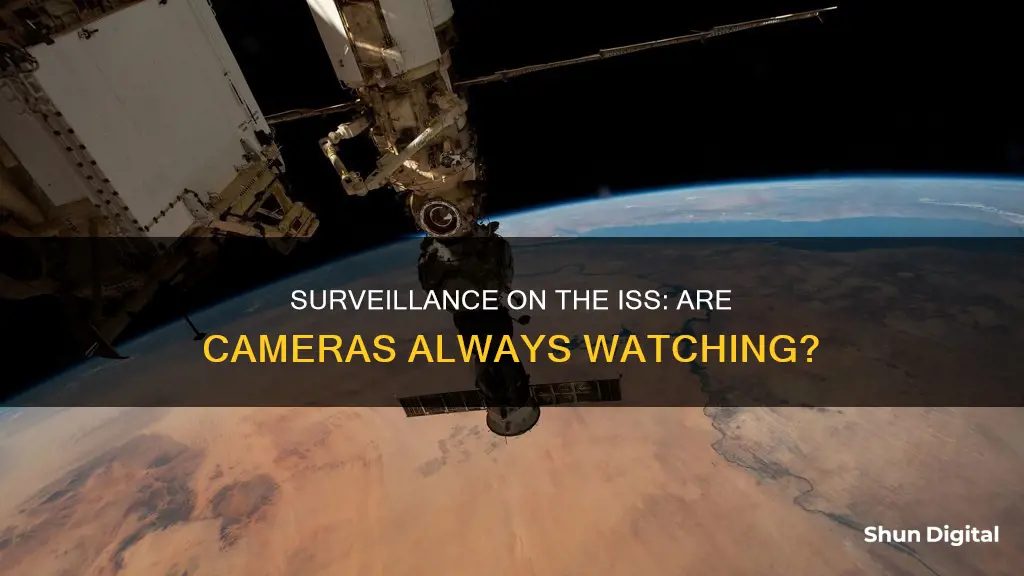
The International Space Station (ISS) is equipped with a multitude of cameras and photography equipment, serving various purposes. Among these, there are two cameras, Theia and Iris, located on the Russian side of the ISS, which are available for space-based video surveillance. These cameras have been pitched for use in border surveillance by a Canadian company, UrtheCast, which operates them with the help of Russia's space agency. In addition to surveillance, the ISS cameras provide stunning visuals of Earth and satellites, with live streaming available for enthusiasts worldwide. The ISS also boasts equipment from renowned brands like Nikon, Sony, and Kodak, underlining the importance of high-quality imaging in space exploration and research.
What You'll Learn

The International Space Station has multiple cameras
There are two cameras, named Theia and Iris, which sit on the Russian part of the ISS and are available to hire for "space-based video surveillance". A Canadian company, UrtheCast, has a deal with the Russian space agency to operate these cameras.
The ISS also has a High Definition Earth-Viewing System (HDEV), which is an external HD camera that captures live video of the Earth. This camera is able to see cities at night and can capture the lights on the surface of the Earth. The HDEV system was activated in 2014 and, in 5 years, was viewed by more than 318 million people across the globe.
In addition to the HDEV, the ISS also has 4:3 standard definition CCTV cameras, and a Nikon D4 in special housing with a motor-controlled zoom. There are also two Raspberry Pi computers on board, one with a standard camera and one with an infrared camera.
Focus Camera Legitimacy: A Scam or Safe Website?
You may want to see also

Theia and Iris are two cameras on the Russian side
Theia and Iris were installed on the ISS in 2014 by Russian cosmonauts Oleg Kotov and Sergey Ryazansky. The cameras are part of a project by UrtheCast, a Vancouver-based company, to provide a live video feed of Earth from space. UrtheCast has commercial rights to images and video taken outside of Russia.
The two cameras work in tandem to capture unique videos and imagery of the Earth. Theia is fixed in place outside the ISS, while Iris rides on a steerable, gyro-stabilised platform controlled by a computer on the ISS. This computer cancels out any vibrations caused by movements of the ISS and keeps the camera pointed at different areas for about a minute at a time.
The images and videos captured by Theia and Iris offer a unique perspective of Earth from space, allowing users to see cars and even people moving around the planet. This level of detail has a wide range of applications, from climate change research to forestry biomass estimation.
The Evolution of Kodak 35 Rangefinder: A Historical Perspective
You may want to see also

Cameras are available to hire for surveillance
There are companies that offer camera hire services for surveillance purposes. Hypervision Security, for example, provides a range of camera rental plans for construction sites, including 4G video cameras for security, surveillance, or on-site management. Their plans offer various features such as 360-degree rotation, HD or 4K resolution, and optional mounts to suit different site needs.
When it comes to surveillance, there are a few notable advantages to renting cameras instead of purchasing them outright. Firstly, rental companies often have the latest technology, ensuring you have access to up-to-date equipment. Secondly, renting can save you from the complicated process of installation and troubleshooting, as these services are usually included in rental packages. Additionally, rental companies typically provide prompt on-site service and replacement in case of any issues, so you don't have to worry about dealing with manufacturers directly.
In terms of pricing, Hypervision Security's basic plan starts at $49.95 per week, which includes a camera, installation, and data charges. This is a cost-effective option, especially when compared to the expense and hassle of purchasing and maintaining your own fleet of cameras.
Now, if you're wondering about surveillance cameras in a different context, such as on the International Space Station (ISS), there is indeed a live video feed available from an external HD camera mounted on the ISS. This camera provides a view of the Earth and has been streamed by NASA, attracting millions of viewers worldwide.
Button Cameras: How Do They Focus?
You may want to see also

The ISS has 4K video and HD live streaming
The ISS (International Space Station) has had HD live streaming since April 30, 2014, when the High Definition Earth-Viewing System (HDEV) was activated. The HDEV experiment, mounted on the ISS External Payload Facility of the European Space Agency's Columbus module, provided stunning visuals of Earth from space. The live feed offered unique perspectives, including the occasional solar panel passing through the view and cities illuminated at night. This HD live streaming from the ISS has captivated audiences worldwide, with over 318 million viewers on USTREAM (now IBM Video) alone.
The ISS live camera provides a view akin to night vision, offering a clearer look at satellites. Additionally, NASA TV caters to space enthusiasts, showcasing various instruments and interviews with NASA experts. The ISS Tracker provides real-time location information about the ISS. These features collectively enhance our understanding of the ISS and its operations.
While the HDEV experiment ended on August 22, 2019, its legacy continues. The ISS now offers 4K video, providing even more breathtaking visuals of our planet. This advancement in video quality showcases the ISS's commitment to technological innovation and offers viewers an unprecedented opportunity to explore Earth from a new perspective.
The 4K video and HD live streaming from the ISS have significant scientific and educational value. They provide a unique platform for studying Earth, its geography, and human impact on the environment. Students and researchers can observe natural phenomena, such as storms, hurricanes, and the illumination of cities at night. This real-time access to space enhances our understanding of the world and fosters a deeper appreciation for the beauty and fragility of our planet.
The ISS 4K video and HD live streaming are more than just technological feats; they are tools for exploration, education, and inspiring a sense of wonder. By offering these visuals to the public, the ISS has become a virtual observatory, inviting people worldwide to join in the excitement of space exploration and discovery. This level of access to space is unprecedented and serves as a testament to the power of technology in bringing the universe closer to us.
Fremont Camera Tickets: What You Need to Know
You may want to see also

Cameras are used for science and entertainment
Cameras are an integral part of the International Space Station (ISS) and serve multiple purposes, including scientific research and providing captivating visuals for the public. The ISS is equipped with advanced cameras that facilitate Earth observation and contribute to our understanding of the planet. One notable example is the High Definition Earth-Viewing System (HDEV), which was operational from 2014 to 2019. HDEV streamed live video of Earth from an external HD camera mounted on the ISS. This camera provided stunning visuals of our planet, allowing people to witness the beauty of Earth from space. HDEV was more than just a technological feat; it inspired and captivated millions, providing a unique perspective that only a select few astronauts had experienced firsthand.
The cameras on the ISS also have practical scientific applications. For instance, they can observe satellites and track their movement, contributing to our understanding of satellite behaviour and providing valuable data for researchers and engineers. Additionally, these cameras offer a glimpse into the inner workings of the ISS, showcasing the various instruments used and providing insights into their functionality. This blend of science and visual entertainment engages the public, fostering a deeper interest in space exploration and the work conducted aboard the ISS.
One of the most captivating aspects of the ISS cameras is their ability to capture Earth at night. With the HDEV system, people could witness the lights of cities from space, a breathtaking sight that underscores the impact of human civilisation on our planet. The cameras also provide a unique perspective on the ISS itself, with occasional glimpses of solar panels passing through the view, reminding viewers of the intricate infrastructure supporting the station's operations.
The ISS camera systems, such as NASA TV, also provide educational value by featuring interviews with NASA experts and speeches. This blend of visual access to the ISS and scientific expertise enhances public understanding of space exploration and the challenges faced by astronauts and researchers. The cameras aboard the ISS serve as our eyes in space, providing a window to the vastness of the universe and our tiny yet magnificent planet. They inspire curiosity, wonder, and a deeper appreciation for the world we live in, all while advancing scientific research and public engagement.
Evernote Camera Mode: How to Switch and Use It
You may want to see also
Frequently asked questions
Yes, the International Space Station has a large number of cameras, lenses, and other photography equipment on board.
The two cameras on the ISS are named Theia and Iris.
The two cameras were installed with Russia's help and are located on the Russian part of the International Space Station.
Yes, the public can access live video footage from the ISS. The ISS live camera gives a view similar to that of a night-vision camera, allowing viewers to see satellites.
The ISS uses a variety of cameras, including the Nikon D4, Nikon D5, Nikon Z 9, Sony α7S II, and Kodak 760C.







